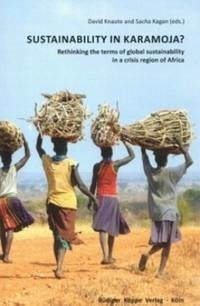Obwohl sie zu einem der am stärksten und längsten von Dürre und Krieg betroffenen Krisengebiete Afrikas zählt, ist die Karamoja-Region im Nordosten Ugandas wenig bekannt und beachtet. Beinahe 30 Jahre nach der historischen Hungersnot von 1980 vermischen sich politische und ökologische Faktoren nach wie vor und führen für die 1 Million pastoral lebenden Karamojong zu einer beispiellosen Belastung. Hervorgegangen aus fünf internationalen Konferenzen, die ihrerseits Teil einer Aktionskampagne in ganz Europa waren, beleuchtet das vorliegende Werk die globalen Verantwortlichkeiten und erforscht lokale, nationale und internationale Lösungsvorschläge, die den Weg ebnen könnten für Nachhaltigkeit und Konfliktminderung in der Region. Aufgrund der interdisziplinären Auswahl der beitragenden Forscher und Experten und einer Gegenüberstellung von europäischen und afrikanischen Fallbeispielen bietet dieses Buch auch Anregungen für andere Pastoralgesellschaften weltweit. Entwicklungshelfer, Forscher, Studenten, Entscheidungsträger und andere Personenkreise, die sich mit Afrika, nomadischen Lebensweisen oder den Auswirkungen des Klimawandels befassen, werden anregende und sogar herausfordernde Perspektiven vorfinden, die alle zusammengesehen ein neues Licht auf die Komplexität humanitärer Krisen und der Menschheitsentwicklung werfen. INHALT: Louis Michel / Elizabeth Paula Napeyok: Foreword David Knaute: Rethinking Sustainability in Pastoralist Areas of East Africa – Introduction PART ONE — Searching for Sustainability in Karamoja Chapter 1 David Knaute: Literature Review on Karamoja (Period 1943–2008) Chapter 2 Sacha Kagan / Liv Pedersen / Sally Ollech: The Karamoja Syndrome – Transdisciplinary Systems Research Informing Policy and Advocacy Chapter 3 Under the guidance of ACTED / Leuphana University Lüneburg: Reaching the Frontiers – Perspectives on Sustainable Development Strategies in Karamoja PART TWO — Pastoralism Globally and Locally Chapter 4 Pastoralism and Development in the Age of Globalization – Comparative Perspectives from Europe and East Africa Hubert Beckmann / Jesús Garzón Heydt: Transhumance as a Tool of Species Conservation in Times of Climate Change Jorge Guerra González: Interculturality as Background for Sustainability Mark J. Dwyer / Kirill V. Istomin: Technological Carrying Capacity Renders Ecological Carrying Capacity a Redundant Concept in Pastoralist Systems? A Case Study of ‘Overgrazing’ amongst Komi and Nenets Reindeer Herders Sylvain Froidevaux: Cattle Raiding and Black Market – From Sociocultural Practice to Subversive Sociability in African Postcolonial Context Wario R. Adano: Development Policies, Reactive Aid and Indigenous Institution of Livestock Sharing among East African Pastoralists Nene Mburu: Ilemi Triangle, the Complexityof Disarming ‘Fragmentary’ Societies Wolde Wendessen Gulelat: The Role of NGOs in Pastoral Advocacy – Experiences of Pastoralist Forum Ethiopia Marion Rolle: The Forgotten Perspective of Climate Policy – Women and Climate Change. The Example of Tanzania Chapter 5 — Multifaceted Perspectives on the Karamoja Crisis Mario Cisternino: How the Karimojong Pastoralists Manage Their Territory – The Ecological Circle of the Pastoralists and the Social Structure Holding it Together Ben Knighton: Can Notions of Common Property and the Common Good Survive? The Consequences of Classical Economics for Karamojong Nomadic Pastoralists Itsuhiro Hazama: Disarmament Policies for Ending Armed Conflict in an East-African Pastoral Society Evelyn Mathias / Thomas Loquang / Ilse Köhler-Rollefson: Community-based Breed Documentation as a Tool for Empowerment – The Example of Karamoja Jeanne T. Gradé / R.B. Weladji / P. Van Damme: Embracing Ethnoveterinary Knowledge Diffusion in Karamoja, Uganda: A Strategy to Strengthen James Lemukol: Health Care Delivery to a Semi-nomadic Population – The Experience of Karamoja Sandra Gray: Economic Activities of Karimojong Men and Women in Two Villages in Moroto District, August–December, 2004 PART THREE — Thinking out of the Box – Cultural Strategies for Awareness Raising Chapter 6 — Examples from the Karamoja Campaign Karl Lakolak: Karamojadream Sylvain Froidevaux: Caution Border – Art Intervention by the CCC Research-based MA Programme at Geneva University of Art and Design (HEAD) Lena Wäbs: Learning Interculturality – A Cultural Exchange between a Gymnasium in Germany and a ABEK school in Karamoja Sacha Kagan: Land of Thorns – A Filmic Attempt to Mediate Issues of (Un-)sustainable Development Sacha Kagan / David Knaute: A Photographic Exploration of Karamoja REZENSION: „The work is well intentioned, with the important goal of improving the lot of pastoralists, specifically the Karamojong, by advocating for the acceptability and even benefit to society of their nomadic lifestyle.“ (Lorelle Beth Jabs in „African Affairs“ 110/439, 2011, 315-316)
Bitte wählen Sie Ihr Anliegen aus.
Rechnungen
Retourenschein anfordern
Bestellstatus
Storno

